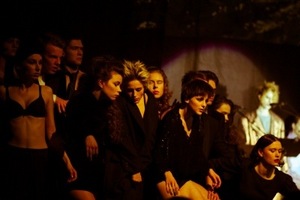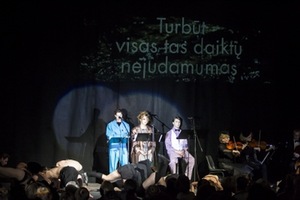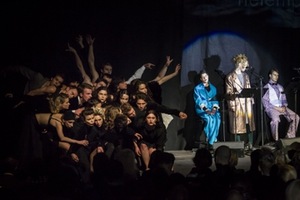No more nymphs 3
In brief: One could write separately about each of the concerts of the recently finished 23rd international actual music festival Gaida. Each of them deserves such attention. However, this time the author invites to look at its “dessert” part, Post Scriptum programme. Usually (although not every year), it becomes one of the more outstanding accents of the festival. Also, Post Scriptum concerts have to be waited for a while after the festival.
In 2012 listeners of Gaida waited for the ensemble of the composer Gavin Bryars, the famous representative of American minimalism, in 2009 – for the programme of St. Christopher Chamber Orchestra and Petras Geniušas, in 2007 – for the concert of Michael Nyman’s group.
This time it was the musical theatre performance “Lost Time” directed by Oskaras Koršunovas. The author Gabija Grušaitė used quotations from Marcel Proust Á la recherche du temps perdu (In Search of Lost Time), Bret Easton Ellis Less Than Zero, American Psycho, Thomas Stearns Eliot The Waste Land while writing the libretto. Music was created for the performance by the composers’ team CoDA NoVA (Remigijus Merkelys, Vytautas V. Jurgutis, Gintaras Sodeika, Egidija Medekšaitė), and it was performed by Asmik Grigorian (soprano), Alina Orlova (vocals), Viktor Gerasimov (sopranino) and chamber instrumental ensemble.
The author states that, thinking in theatre conventions, the performance was rather Brecht-like, it used principles close to Brecht epic theatre: the “illusion of the fourth wall” was eliminated, amateur actors replaced Stanislavsky-like empathy with the role, and they did not try to hide that they only performed their characters as they could. Dramaturgy based on the unity of place and time was deconstructed by the fragmented and torn story that was told in parallel mise-en-scenes visually and semantically. It was shown emphatically that the story was told and attention was drawn to how it was made and what was being told.
The intensive dynamics of the performance made the spectator look to different sides of the podium that surrounded the pit, in which actors were divided, and to observe at the same time how the parts were performed by actors and instrumental ensemble on the stage. Round video projections also demanded attention. The proximity of the podium determined the fact that the spectator often felt in the epicentre of action – the trajectories of his/her look became part of the sight.
Thus, the author concludes that “Lost Time” was a time of intensive experience full of dynamically changing views, tonalities, metaphors and energy. Perhaps somebody was encouraged to search for the lost time along with Proust, perhaps someone will dip into thought about the river of time and Eliot’s desserts meditating traces of disappeared nymphs covered in sand. Others will remember the psychedelic grimaces of American Psycho and will meet them with an ironic smile in the mirror.




